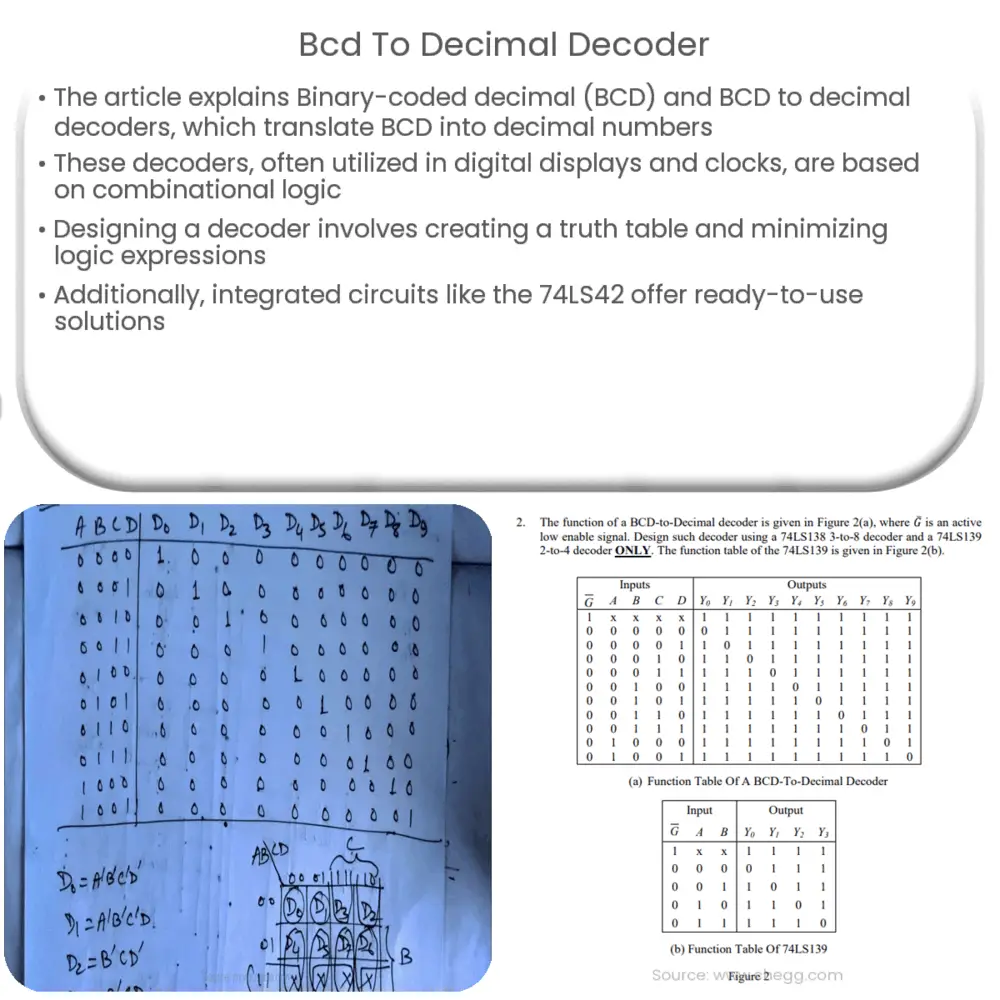A BCD to decimal decoder is a digital circuit that converts binary-coded decimal (BCD) inputs into corresponding decimal outputs for display or processing purposes.

BCD to Decimal Decoder: An Introduction
Binary-coded decimal (BCD) is a class of binary encodings that represents decimal numbers using four bits. A BCD to decimal decoder, as the name implies, is a digital circuit that decodes BCD values into their corresponding decimal numbers. In this article, we will discuss the fundamentals of a BCD to decimal decoder, its applications, and how it works.
Understanding BCD
Before diving into the details of a BCD to decimal decoder, it is essential to understand the concept of binary-coded decimal. BCD is a binary representation of decimal digits, where each decimal digit is represented by a group of four binary digits or bits. For example, the decimal number 9 would be represented as 1001 in BCD.
BCD is commonly used in digital systems where it is necessary to display or manipulate decimal numbers. One significant advantage of BCD is that it simplifies the process of converting binary to decimal and vice versa. However, BCD is less efficient than pure binary representation, as it requires more bits to represent the same decimal value.
BCD to Decimal Decoder: The Basics
A BCD to decimal decoder is a combinational logic circuit that takes a BCD input and generates a decimal output by activating one of its output lines corresponding to the decimal value of the input. The decoder has four input lines for the BCD code and 10 output lines for the decimal digits (0 to 9).
For example, when a BCD value of 1001 (decimal 9) is input into the decoder, it activates the ninth output line, which corresponds to the decimal number 9. Similarly, if the BCD input is 0110 (decimal 6), the sixth output line will be activated, representing the decimal number 6.
Applications of BCD to Decimal Decoder
BCD to decimal decoders play a crucial role in various digital systems and applications. Some of the most common applications include:
- Seven-segment displays: BCD to decimal decoders are widely used in conjunction with seven-segment displays to show decimal digits. The decoder translates the BCD input into a decimal output, which is then used to drive the corresponding segments of the display.
- Digital clocks: In digital clocks, BCD to decimal decoders are employed to convert the BCD representation of hours, minutes, and seconds into their respective decimal values for display purposes.
- Arithmetic units: BCD to decimal decoders are also used in arithmetic units of digital systems, such as calculators and microprocessors, to handle decimal operations and conversions between different number representations.
How BCD to Decimal Decoder Works
The operation of a BCD to decimal decoder is based on combinational logic. The decoder employs logic gates, such as AND, OR, and NOT gates, to generate the appropriate decimal output based on the BCD input. The design of the decoder can be achieved using various methods, such as truth tables, Karnaugh maps, or Boolean algebra.
Designing a BCD to Decimal Decoder
To design a BCD to decimal decoder, we can start by creating a truth table that maps each BCD input to its corresponding decimal output. This table will serve as the basis for determining the required logic gate connections to implement the decoder circuit.
Next, we can use Karnaugh maps or Boolean algebra techniques to minimize the logic expressions for each output. Minimization is essential to reduce the complexity and number of gates needed in the final circuit.
Once the simplified logic expressions are obtained, the decoder can be constructed using AND, OR, and NOT gates to implement the corresponding expressions for each output line. The resulting circuit will decode the BCD input and produce the appropriate decimal output as specified in the truth table.
BCD to Decimal Decoder ICs
In addition to designing BCD to decimal decoders using discrete logic gates, integrated circuits (ICs) are also available for this purpose. These ICs come in various configurations and provide a compact, ready-to-use solution for implementing BCD to decimal decoding in digital systems.
One popular example of such an IC is the 74LS42 BCD to decimal decoder. The 74LS42 is a 4-to-10 line decoder that accepts a 4-bit BCD input and generates one active-low decimal output corresponding to the input value. This IC can be easily interfaced with other digital components, such as seven-segment displays or arithmetic units, to perform BCD to decimal conversion in various applications.
Conclusion
BCD to decimal decoders play a vital role in many digital systems, enabling the conversion of BCD representation into decimal values for display or processing purposes. These decoders can be designed using combinational logic with discrete gates or implemented using integrated circuits for a more compact and efficient solution. Understanding the principles and operation of BCD to decimal decoders is crucial for anyone working with digital systems, as it provides valuable insight into the processing and manipulation of decimal data within these systems.
By mastering the concepts and techniques involved in BCD to decimal decoding, you can better design and implement digital systems that require decimal number handling, enhance your understanding of digital electronics, and contribute to the ongoing advancements in the field of digital technology.

